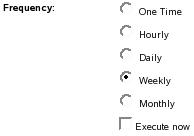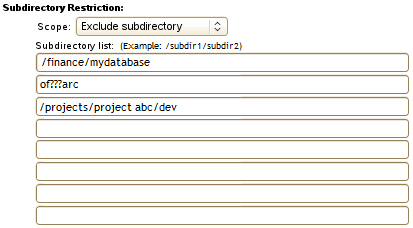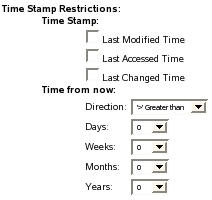10.1 Understanding Shadow Volume Policy Options
Shadow Volume policies manage how files are distributed across the shadow volume’s primary and secondary areas. A Shadow Volume policy allows you to specify when the policy is enforced (one time, hourly, daily, weekly, and so on), which volumes the policy applies to, which direction files are moved (primary area to its secondary area, or secondary area to its primary area), and which files are moved (by file name, file type, time stamps, or file size).
DST policies are configured in Novell Remote Manager for Linux. DST provides the following policy options:
10.1.1 Last Executed
For an existing policy, the parameter reports the last time the policy ran successfully. This parameter is not configurable.
10.1.2 Description
is the user-defined name for the policy. It should be descriptive of the policy it represents, and meaningful to the administrator. This name appears in the table on the main page.

10.1.3 Start Time
specifies the time of day to begin a run to enforce the policy. For hourly policies, the policy enforcement begins at the selected minutes past each hour. Time is specified based on a 24-hour clock. For example, 18:00 (6:00 p.m.) is the default start time.

10.1.4 End Time
specifies the time of day to stop work on an enforcement run. Specifying an end time for a scheduled run allows you to prevent policy enforcement from happening during busy work hours. Time is specified based on a 24-hour clock. For example, 07:00 (7:00 a.m.) is the default end time.

If the policy enforcement process is still running when the end time is reached, the policy’s queued work is paused until the next scheduled run. When the policy run begins at its next scheduled time, it continues with the queued work, and adds new work to the end of the queue.
10.1.5 Start Day
For policies that run weekly, specifies the day of the week to enforce the policy. You can specify only one day of the week for a given policy. Options are (default), , , , , , or .

For policies that are run one time or monthly, specifies the month and day of the month when the policy is scheduled to be enforced.
10.1.6 Frequency
specifies how often the policy is enforced when the is set to . Table 10-1 describes each frequency option. The option can be selected or deselected in combination with any one of the scheduled frequency options.

Table 10-1 Frequency Options for DST Policies
|
Option |
Description |
|---|---|
|
|
Whenever the policy’s is set to , the policy runs one time, then changes the to . You can activate the policy to run again by changing its status. |
|
|
The policy enforcement process runs once each hour. It begins at the number of minutes past the hour specified by the . The process continues until it is done, or until the number of minutes past the hour specified by the . Unfinished work is queued until the next run. |
|
|
The policy enforcement process runs once each day. It begins at the time specified by the . The process continues until it is done, or until the time specified by the . Unfinished work is queued until the next run. |
|
(default) |
The policy enforcement process runs once each week. It begins on the day of the week specified by the . The process continues until it is done, or until the time specified by the . Unfinished work is queued until the next run. |
|
|
The policy enforcement process runs once each month. It begins on the month and day specified by the , then it runs every month afterwards on that day of the month. The process continues until it is done, or until the time specified by the . Unfinished work is queued until the next run. |
|
|
Select this option to run the policy now, in addition to its regularly scheduled runs. The policy enforcement process is initiated within a few minutes after the policy’s is set to and saved (submitted). The process continues until it is done, or until the time specified by the . Unfinished work is queued until the next run. |
10.1.7 Command Status
governs whether a policy is actively enforced or inactive. Inactive policies can be changed back to active. New policies can be created and set to inactive without running them. Options are (default) and .

10.1.8 Volume Selection
allows you to specify the shadow volumes affected by a given policy. You can select one or multiple shadow volumes from a drop-down list of existing shadowed volumes, or select . You can have multiple policies associated with a given shadow volume. A given policy can apply to multiple shadow volumes.

When you work with DST shadow volumes in a cluster, you should create separate policies for the shadow volumes that exist in a given cluster resource. A given policy can apply to multiple shadow volumes in the cluster resource. You can have multiple policies associated with a given shadow volume in the cluster resource.
10.1.9 Volume Operations
specifies the direction the files are moved between the primary storage location (primary area) and the secondary storage location (shadow area).

Table 10-2 Volume Operations for a Policy
|
Option |
Description |
|---|---|
|
(default) |
When the policy is enforced, all files on the primary storage location that meet all of the search criteria are moved from the primary storage location to the secondary storage location. |
|
|
When the policy is enforced, all files on the secondary storage location that meet all of the search criteria are moved from the secondary storage location to the primary storage location. |
10.1.10 Subdirectory Restrictions
In the area, you specify the and information that determines whether the policy applies to everything in a volume, only to a specified directory (and its contents), or to all directories but the one specified.

The options allows you to specify included paths or excluded paths in a given policy, but not both. Table 10-3 describes the options for :
Table 10-3 Subdirectory Restrictions for the Scope of a Policy
|
Option |
Description |
|---|---|
|
(default) |
The policy is enforced for all subdirectories in the volume. Do not specify a path. |
|
|
The policy is enforced only for a specified subdirectory and its contents. You can specify multiple paths to be included when running the policy. |
|
|
The policy is enforced for all subdirectories in the volume, except for the specified subdirectory and its contents. You can specify multiple paths to be excluded when running the policy. For OES 2 with the latest patches applied, the Exclude Subdirectory option also allows you to specify a directory name that might exist in multiple places on a volume. You indicate this intended action by specifying only a directory name with no forward slashes, and the directory name must contain at least one wildcard (such as ? and *). All instances of directories that match the specified directory name are excluded from the policy run. |
The allows up to 8 subdirectory paths on the primary volume to be specified for being included or excluded in a policy when it runs. Each additional path that you specify requires another pass through the data, so it increases the time needed to enforce the policy.
Specify the subdirectory paths relative to the root of the DST volume, not the full Linux path. Wildcards are not allowed in a subdirectory path. Each path must point to a valid subdirectory in the file system.
Precede subdirectory paths with a forward slash (/). For example:
/subdir1/subdir2
Directory names with spaces in them are supported in the subdirectory paths. For example:
/projects/project abc/dev
For OES 2 SP3 with the latest patches applied, the Exclude Subdirectory option supports using wildcards to specify a directory that might exist in multiple places on a volume. For example, to exclude all GroupWise archive subdirectories, specify the following directory name with wildcards:
of???arc
Table 10-4 demonstrates how to take advantage of the ability to specify subdirectory paths and directories that have multiple occurring instances in the DST volume.
Table 10-4 Sample Extended Subdirectory Entries and Intended Actions
|
Exclude Subdirectory Entry |
Intended Action for the Policy |
|---|---|
|
/test |
The preceding forward slash indicates that this is a subdirectory path relative to the root of the volume. This entry excludes only the /test directory located at the root level of the DST volume. |
|
tes? |
The absence of a forward slash and the presence of a question mark wildcard (?) in the directory name indicates that this is a directory that might have multiple instances as subdirectories in the volume. This entry excludes all instances of directories with 4 characters in the name that match the first 3 characters, and any character in the 4th position of the directory name. |
|
tes* |
The absence of a forward slash and the presence of an asterisk wildcard (*) in the directory name indicates that this is a directory that might have multiple instances as subdirectories in the volume. This entry excludes all instances of directories with names of any length that match the first 3 characters, and any characters to the end of the directory name. |
|
test |
No actions are taken for this entry. It is not preceded by a forward slash, so it does not qualify as a subdirectory path. It does not contain a wildcard, so it does not qualify as a directory entry. |
10.1.11 Search Criteria
Files must match all of the specified criteria in order to be moved between the primary storage location and secondary storage location. Criteria options include file name or extension, time stamp, and file size. The conditions are combined (and-ed) together, which means that all conditions must be true for a file before it is queued for moving to the other location. Specify any of the following search criteria:
Search Pattern
allows you to set criteria based on the file name or extension. You can specify characters and wildcards to search by file name. You can specify files by types by specifying a wildcard and an extension, such as *.mp3. The default entry is *.*, which applies the policy to all file names and all file types.

You can specify up to 50 extensions in a given policy. Separate the multiple entries with a comma and no spaces. For example, to specify multiple image file extensions, type the following:
*.bmp,*.jpg,*.png,*.tif
For OES 2 SP3 with the latest patches applied, you can specify files with spaces in the name. Enter the file name without quotes.
filename with spaces.txt,another file with spaces.jpg,yet another file.doc
Time Stamp Restrictions
identifies which time stamps to use when applying the policy.

The time stamp types are:
-
Last Time Modified: Time of last content modification for the selected file.
-
Last Time Accessed: Time of last access.
-
Last Time Changed: Time of last file status change.
The default is no time restriction (all Time Stamp options are deselected), so the default policy applies the policy for all existing files.
These time stamps are defined by POSIX and supported by Linux. Many operations change more than one time stamp. NCP can modify the access time and the modify time, but cannot control whether the change time is reset. The Last Time Changed value is controlled automatically. For example, if you copy a file from one location to another, NCP preserves the access and modify times, but the change time is reset because the file’s path changed. That is, it had a status change but the file was not opened for access and its data was not modified.
You must also specify the specific time period to use in . Direction options are and . Specify a direction, then select one of the time periods described in Table 10-5.
Table 10-5 Time Periods for the Time Stamp Restrictions in a Policy
|
Option |
Description |
|---|---|
|
|
Specify 0 to 14 days. 0 days (the default) disables the option. |
|
|
Specify 0 to 10 weeks. 0 weeks (the default) disables the option. |
|
|
Specify 0 to 24 months. 0 months (the default) disables the option. |
|
|
Specify 0 to 24 years. 0 years (the default) disables the option. |
For example, you can select all files that have a modified time greater than 6 months by selecting in the field, for the field, and 6 in the field.
File Size Restriction
Specifies the range of file sizes to search. specifies to look for files that are greater than or less than the specified size in KB. Specify a value of 0 KB to disable the file size restriction. The default is no size restriction, which applies the policy for files of all sizes.

10.1.12 Stop
Beginning in OES 2 SP3 Linux, a button is available on the policy’s View/Edit Shadow Volume policy page when the policy is running. You can use this option to stop an individual currently running policy. For information, see Section 10.7, Stopping a Running Policy.
You can stop all currently running policies by using the option on the Dynamic Storage Technology Options page.